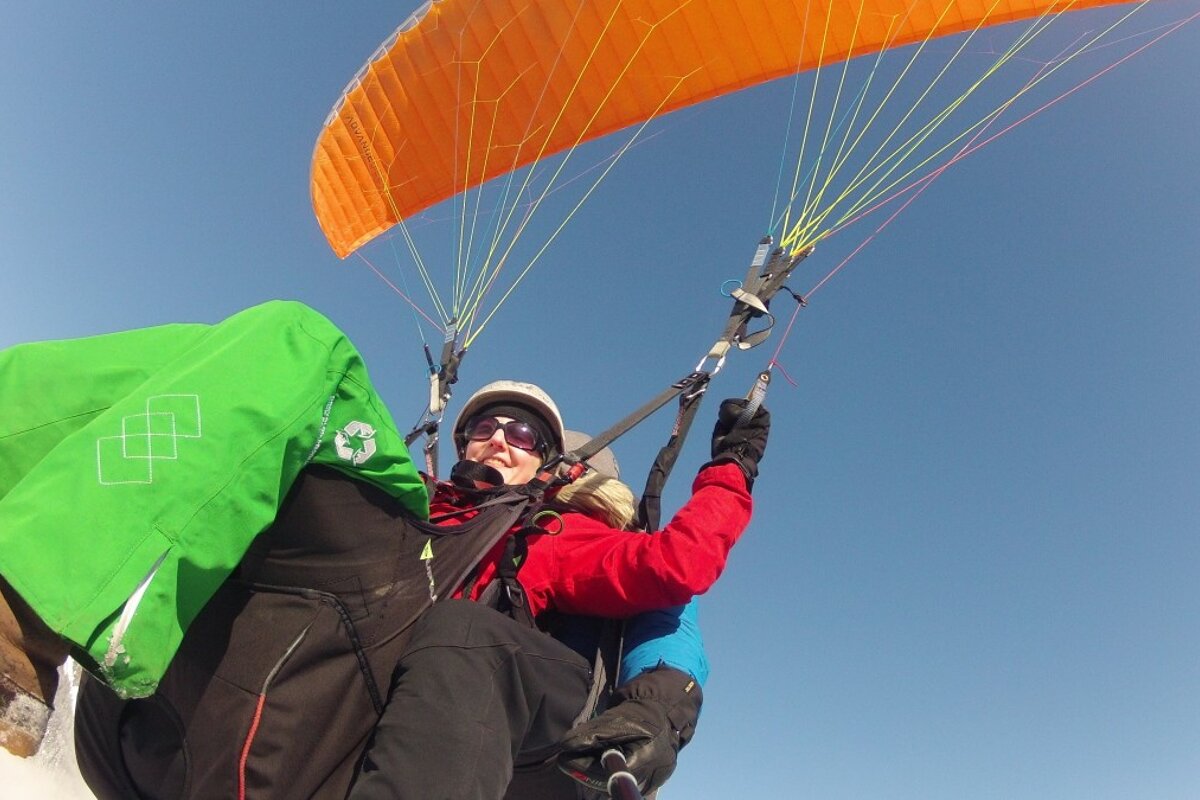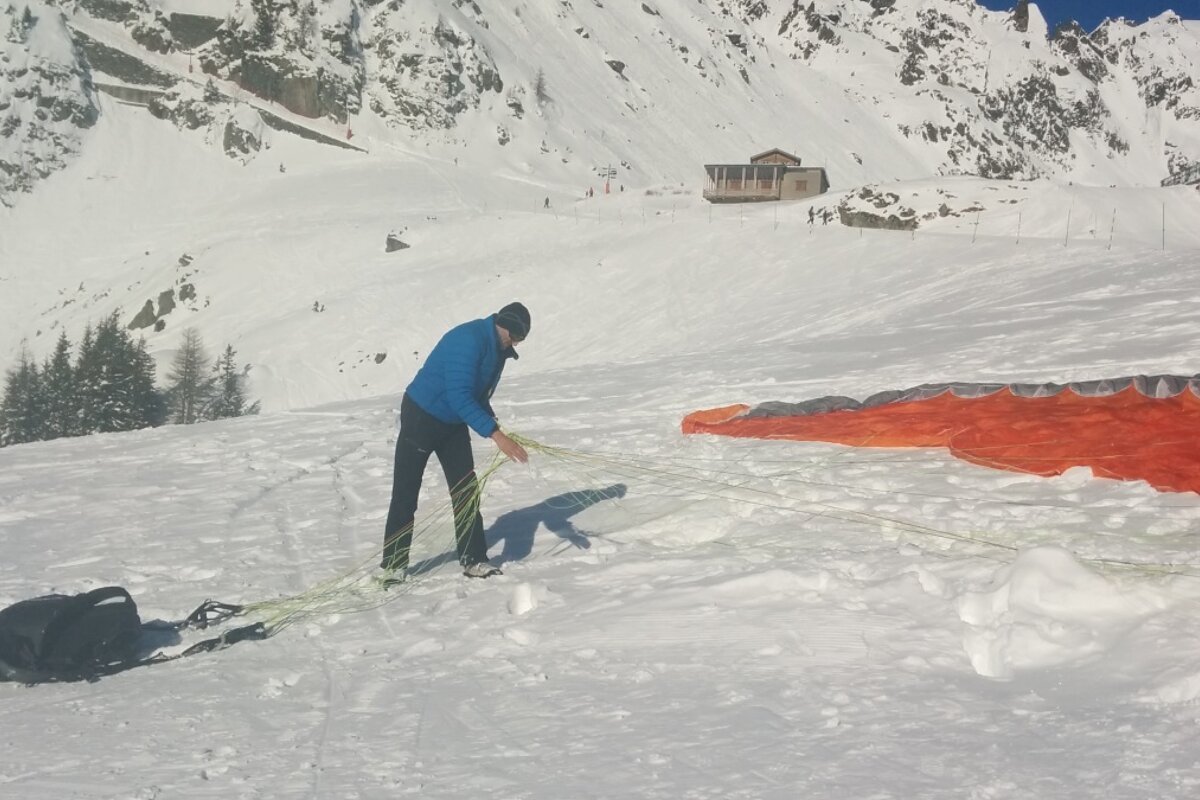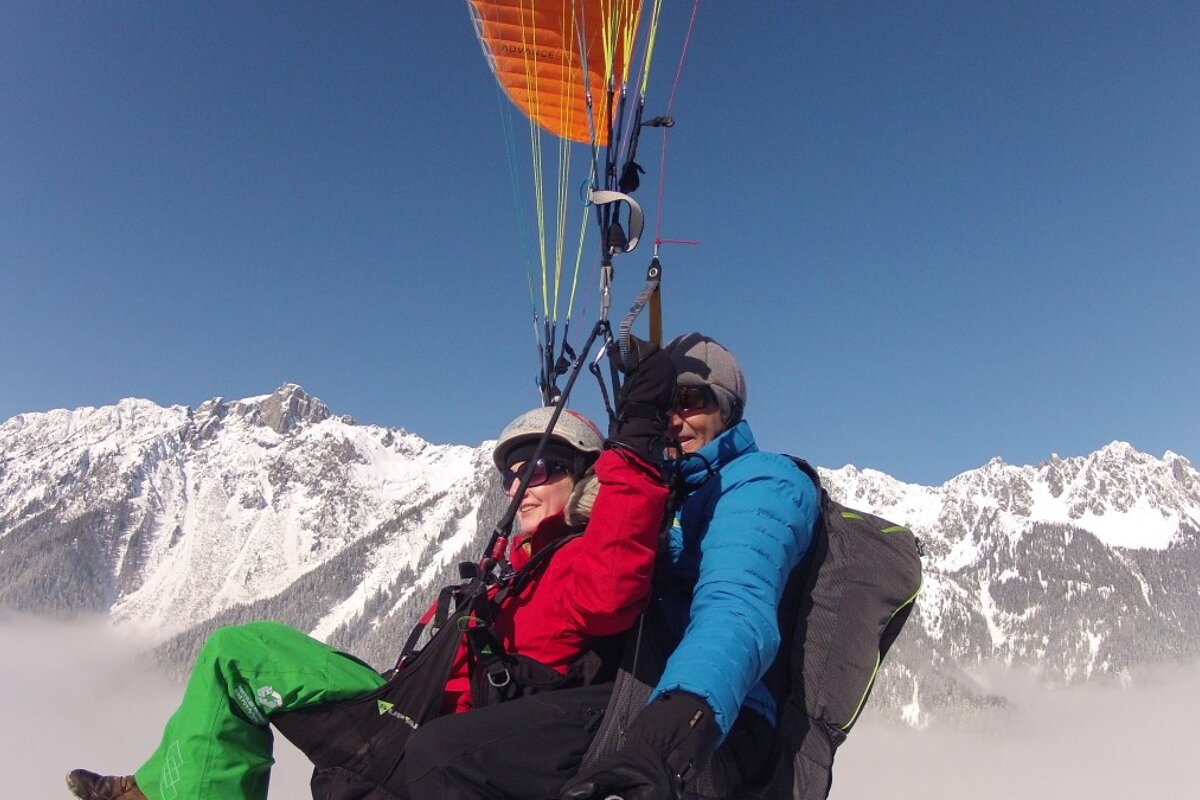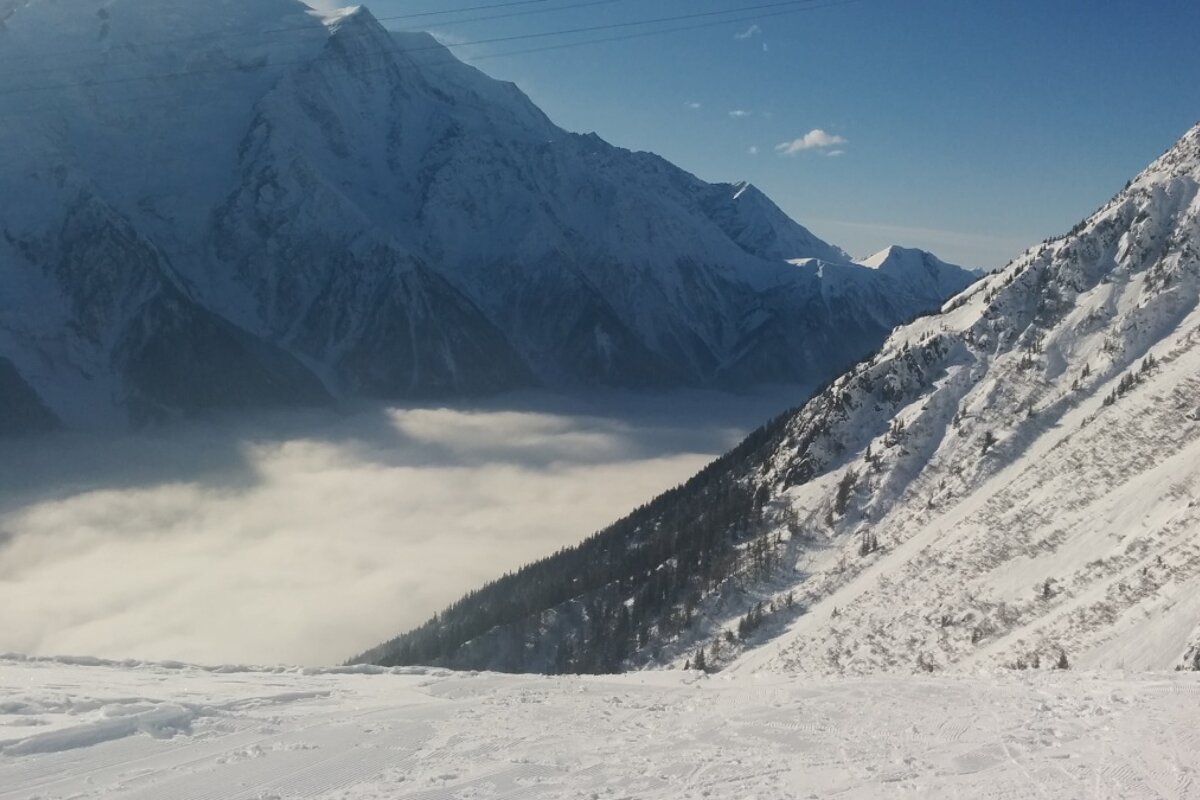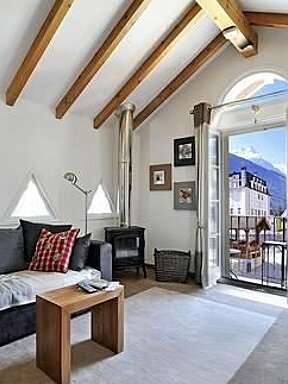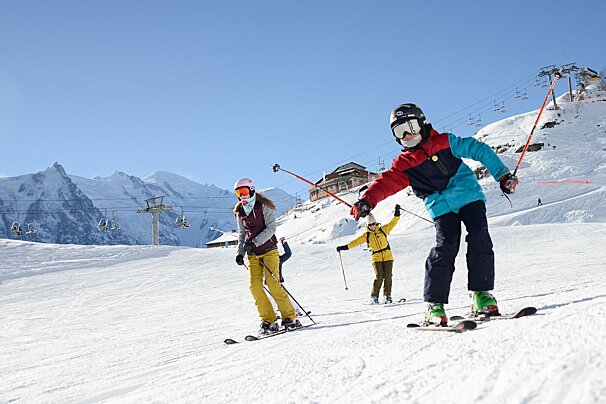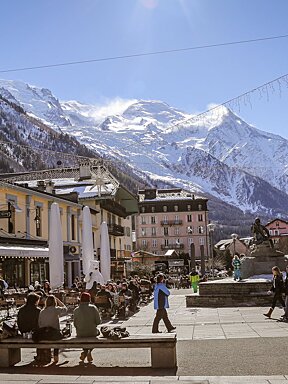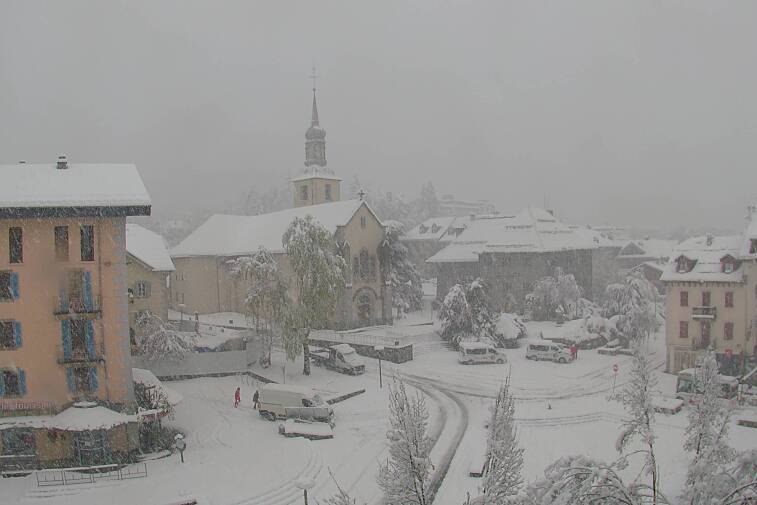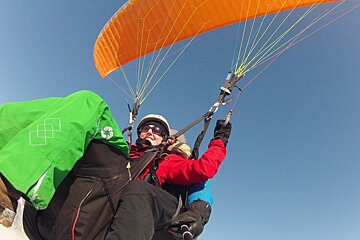
© Fly Chamonix - Sean Potts
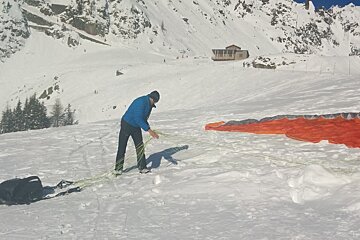
© Jemima Lang
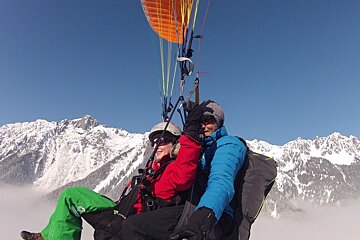
© Fly Chamonix - Sean Potts
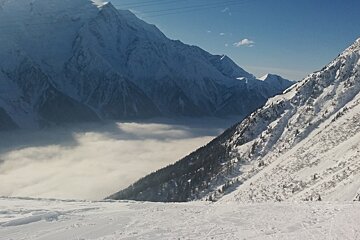
© Jemima Lang
Paragliding in Chamonix
Discover the top Chamonix parapenting
If you’ve never tried paragliding before (or maybe you’re not entirely sure what it is) then Chamonix is a great place to learn how to fly.
Known as “parapenting” in France, today there are a number of clubs and organisations in the area whose sole purpose is to get you flying. So, if it's something that you have always fancied trying then Chamonix is a great place to give it a go.
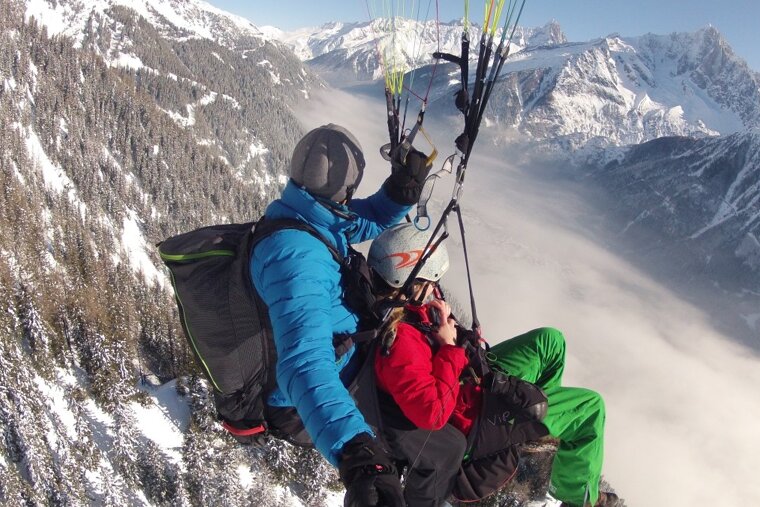
The science
Often described as the "purest and simplest form of aviation", stemming from man’s long term ambition to be able to fly, others simply call it "a pure joy". Paragliders were originally developed from parachuting canopies, although it soon became apparent that the two required very different design criteria. Whilst a parachute has to withstand the incredible stresses of opening in free-fall and enable the pilot to descend at a fairly rapid rate; a paraglider is fully inflated before take-off, launched from the ground and requires a good gliding performance and a slow rate of descent. Paragliders began to take on more of the design features of the hang glider with a high-lift aerofoil shape and long slender wings. It is currently one of the fastest growing air sports in the world with much of its attraction being in the portability of the equipment; a canopy that weighs relatively little, fits in a large rucksack and can be taken all over the world.
Now for the science bit. When a paraglider is fully inflated it forms a solid “wing” which creates lift in the same way as that of a conventional aircraft. It must create enough lift to carry its own weight and that of the pilot and any passengers, and it achieves this with “gliding flight”. This means that the wing is constantly flying forwards and downwards through the air and in doing so provides a flow over the aerofoil section.
The pilot controls the wing with a series of suspension lines that are thin, but very strong, in order to minimise drag and weight. These lines converge into “risers” (usually 25mm webbing straps) that are attached to the harness and spread the weight load evenly over the wing. They also provide the pilot with a convenient single point to hold when launching, and channel the control lines down to the pilots’ hands so that he or she can steer. The controls are the equivalent of the brakes and steering wheel of a car and so by turning left and right and into and out of the wind or thermals, the pilot is able to speed up, slow down and gain or lose height. Modern paragliders are made out of super lightweight nylon meaning they can soar effortlessly through the air for hours on end in the right conditions.
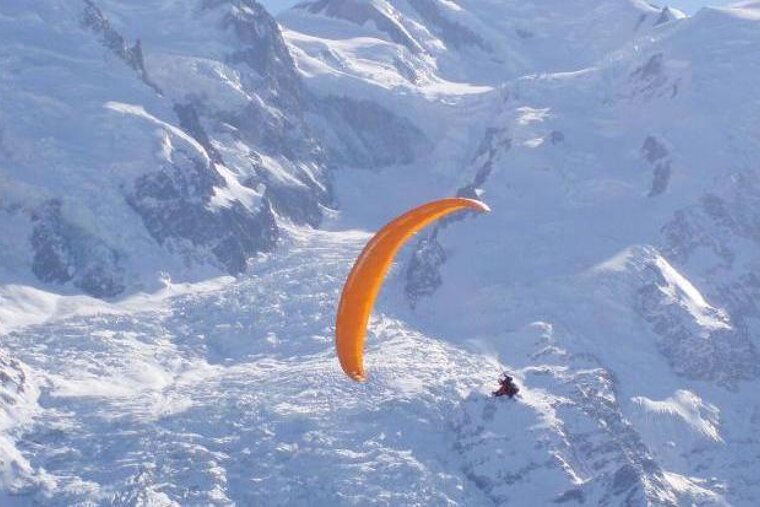
Who can paraglide and what to wear
Pretty much anyone can paraglide, from little nippers to your granny as long as they can run approximately 10 metres for the take off. Flying itself does not require much physical effort (especially if you’re the passenger), hence why people of all ages and occupations can experience the delights of soaring above the mountain tops with only the birds for company. The main take off areas can be accessed by one of the chairlifts, and from the top it is usually just a short walk to the take off area.
Flights can be undertaken solo (but only with prior training from a qualified instructor) or in tandem with a qualified paragliding pilot, therefore opening up the experience to pretty much anyone. Pilots (and their passengers) wear a comfortable “seated” harness that is securely attached to the paraglider (and also to each other, with the pilot behind in the case of tandem flights). The paraglider itself is laid out flat on the ground of the take-off area and the pilot then fully inflates the wing by moving forward when a gentle gust of wind blows. Once inflated, both pilot and passenger run forward a few steps on a downward incline and, with a little manoeuvre from the pilot, you’re airborne.
From a height you will glide down to your destination on a tandem paraglider controlled by the instructor. They manoeuvre the parachute while the passenger enjoys the ride and fantastic views. Taking off is the only slightly scary moment; once you have been equipped with a helmet, and strapped to the instructor behind you, both of you simply run downhill getting faster and faster until the parachute lifts you into the air.
No particular level of fitness is required, just the ability to sit back and enjoy the view. You then peacefully glide above the beautiful landscape below for 10 to 20 minutes, aiming to catch thermals to keep you up for longer. Landing is very gentle and no more of an impact than jumping off a step. Top tip: go on a sunny, warm day when the thermals will keep your airborne for longer.
Clothing is an important factor when flying so you want to wear something that offers a degree of protection from sun/wind/cold etc, even if the weather is hot. Long trousers, a wind proof top, sunglasses and sun cream are essentials, as are good sturdy footwear such as walking boots (with ankle support), which will reduce the chance of slipping on take off or landing.
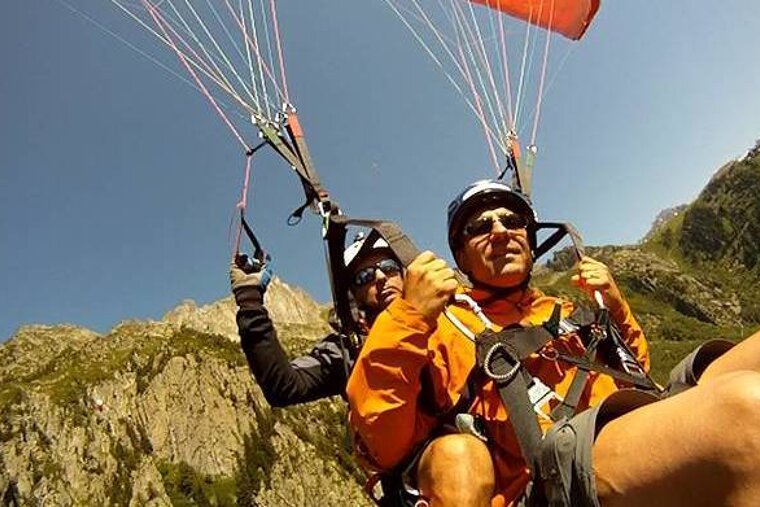
Tandem paragliding
Whether paragliding is a sport that you are thinking of taking up and want to know if you're going to like it; or if you simply want to experience the truly wonderful feeling of flying amongst Chamonix's breathtaking scenery - a tandem flight is the perfect introduction.
When booking a tandem flight, it is best to do so a day or two in advance and try and allow yourself some leeway in case of bad weather. It is not possible to fly in poor weather conditions so if your flight is cancelled for this reason, every effort would be made to reschedule it for the next mutually convenient time. It would be a terrible shame to miss out on the experience because you left it until your last day. The actual timing of your flight will be influenced to a certain extent by your age and size, but only in so much as it is better for children or petite adults to fly earlier in the day when the wind is not as strong. Certain take-off sites are also better at particular times of the day when known weather patterns will be present.
Once you've reached the take off area, the whole process will be clearly and calmly explained and a number of safety checks are carried out before the off. There is no rush at all and sometimes the services of a professional photographer are available at the top to record your big moment. The take off is progressive with no feeling of dropping; it is much more a gentle lift up and away from the ground. Once in the air, very few people feel afraid of the exposure (even vertigo sufferers) as the harness is seated and comfortable and it can feel rather like sitting on a plane (albeit with the windows open!) rather than being on the edge of a cliff.
As the passenger, you can choose how you want to fly, usually moving around the mountain to get different views and perspectives instead of circling over the one spot. Don't forget your camera. Ensure that it has a strap on it so that it can be securely attached to the harness leaving you free to snap away and not worry about dropping it should you fancy taking the controls yourself for a while. The landing is also a gradual affair due to the excellent manoeuvrability of the wing; you may need to run a few steps but it is usually gentle and certainly less dramatic than a parachute landing. Friends and family can wait for you at the landing area (or see you off at the top if you prefer) and you have time to relax and talk to your pilot once back on terra firma.
The whole activity normally takes about an hour with the flight itself lasting about 20 minutes. Sometimes, it is possible for a group of you to fly at the same time so you can normally take photos of each other in the air as the pilots will endeavour to fly you close to one another. Tandem flights are possible any day of the year, weather permitting, and that includes the winter. Flying in winter is actually no colder than skiing and in fact conditions are often more stable in the winter months making it an ideal time to take to the air. The launch is generally done on foot although it can be possible to take off on skis by special request and therefore miss the end of day rush to get off the mountain. All flight schools have strict safety standards to meet and equipment must be checked and maintained regularly. It takes many, many hours of flying to qualify as a tandem pilot so you can rest assured that you will be in highly qualified hands.

Solo paragliding
If flying tandem was not enough for you and you have decided that “going solo” is the only way fly, then you should book yourself onto a beginners course. Regardless of what some reckless souls may say, the only safe way to learn to fly is to be trained by a qualified instructor.
The official regulatory body in the UK is the British Hang Gliding and Paragliding Association (BHPA). They have a list of all the registered flight schools in the UK that offer tuition for all levels of pilot. However, what could be nicer than learning to fly in Chamonix? If fatigue or frustration begins to get the better of you then you only have to glance skywards to be reminded what it's all about.
The French training is split into three separate weeks: the Initiation course, then the Perf 1 and Perf 2 courses. These can be taken individually or back to back, but they don't have to completed all in the same year. A number of schools in the area offer five day Learn to Fly courses from June to October. During the five days you will become familiar with your equipment, learn to master the control of your wing on the ground and make your first solo take-offs from the gentle nursery slopes. The remainder of the course is spent building your skills and confidence with a number of smaller flights and then culminating in long flights from the mid-mountain take-off zones whilst in full radio contact with your flight instructor. These courses are interactive affairs where you are encouraged to ask questions and the instructors will test you on topics covered – after all, your safety depends on it. In order to make the most of these courses, you should be in reasonable physical shape beforehand as you will be walking and running up and down the nursery slopes several times while you get the hang of it.
If you have already completed a basic level course (here or elsewhere), then further tuition is available (and necessary) in order to hone and improve your skills in the sky. Improver courses or specialist training in flying thermals, cross-country and even tips on competitive flying are available. You will be asked for proof of previous flying experience (FFVL niveau vert / BHPA Elementary or Club Pilot or equivalent) before being accepted onto these more advances courses.
If you're already an experienced pilot then you will have an absolute field day flying in Chamonix. However, before setting out to fly in completely unfamiliar territory it is always worth seeking advice from your fellow flying club members or from local pilots when you arrive. The more you know about the site and the region, the safer and more enjoyable your flying will be. Don't rush to be the first to launch; sit and watch what the local pilots are doing as their actions will give you a good indication of prevailing conditions and thermal activity, in addition to your own assessment of the area. Always carry your flying licence or membership card with you and ensure that your medical insurance covers you sufficiently for flying abroad, including third party liability cover.
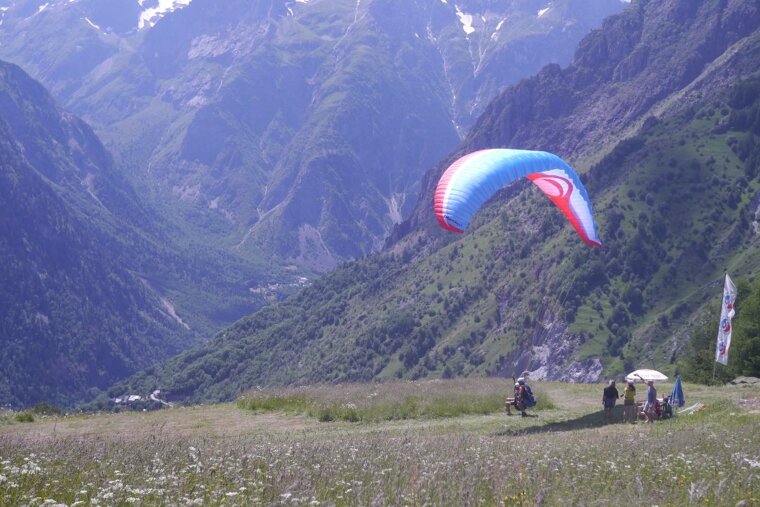
Take-off areas
Nearly all flying sites in France are open to the public although they may be controlled by one of the local flying schools or clubs, in conjunction with the governing body. You may find these schools and their tandem pilots have priority at the launch areas. Some sites, for various reasons may well be closed during parts of the year (especially in the nature reserves when animals have young) so it is important to respect these closure periods.
All the official paragliding sites have notice boards placed at both the launch and landing areas, giving information of school or club address and phone numbers, rescue services phone number or radio frequencies. These notice boards describe launch directions and landing approaches, flying restrictions, wind and thermal turbulence problems if any, areas that may be dangerous to fly near, and so on. Again this information tends to be in French but English translations are becoming more and more common. Keep your pocket dictionary handy just in case!
Attention: The following take off areas are on high mountain glacier terrain. The areas are not marked or surveyed and have numerous dangerous crevasses nearby. Those not experienced in glaciers are strongly advised to employ the services of a high mountain guide before venturing to these areas.
| Area | Orientation | Access and ability | Site Specifics | Landing Area |
| Grands Montets | GPS: N 45° 56' 52" E 006° 57' 36" Direction: West Altitude: 3,100m Vertical Drop: 2,100m |
Access: Cable car Lognan and Grands Montets (two stages). Ten minute walk from lift station and across glacier. Ability: Qualified autonomous pilot with a basic knowledge of alpinism or the presence of a mountain guide. |
Grands Montets is for the experienced pilot, yet surprisingly it is much less frequently flown than the previously mentioned areas. However, at 3,100m, this is a high altitude take off area so you will need to be in good physical condition to fly here. Also be aware that take off is actually on the glacier so be very careful as crevasses are present close by. Best flown in the afternoon once the warm Chamonix air has been pushed up here by the valley wind, this site offers excellent potential for cross country flying. |
Bois du Bouchet |
| Aiguille du Midi | GPS: N 45° 52' 52" E 006° 53' 50" (North Take Off) N 45° 52' 51" E 006° 53' 48" (South Take Off) Direction: North and South Altitude: 3,800m Vertical Drop: 2,700m |
Access: Aiguille du Midi cable car (two stages). Thirty minute descent down the arête (a knife edge ridge) necessitating the use of crampons, preferably a rope. The take offs are both situated on high mountain glaciers with crevasses. Mountaineering experience or the presence of a mountain guide is absolutely essential. Ability: Autonomous pilot with excellent take off technique and a sound knowledge of alpinism or the presence of a mountain guide. |
With 2,700m of vertical drop this is possibly the biggest flight in Europe. The southern take off sends you on an 18km journey above the fabulous Vallée Blanche – the views are amazing! However, as with Grands Montets, this is a high altitude take off area requiring good physical shape and snow conditions can make the take off very tricky. The area can be flown throughout the day although during the winter; access to the take off area is made slightly easier once the fixed line is put in place for skiers doing the Vallée Blanche. It is not possible to fly in this area during July and August. | Bois du Bouchet (Note: There is no landing area in Argentière as all previous sites are now completely forbidden) |
| Area | Orientation | Access and ability | Site specifics | Landing field for: |
| Planpraz | GPS: N 45° 56' 08" E 006° 51' 18" Direction: South and North East Altitude: 2,000m Vertical Drop:1,000m |
Access: Planpraz gondola and then 10 minute walk uphill to launch site. Ability: Supervised beginner to cross country (XC) pilot. |
Situated on the north side of the Chamonix Valley, Planpraz has two take-off sites in close proximity to each other – one south facing and the other north easterly. This is one of the most popular sites in the area with local schools and clubs, meaning the take-off area can get quite busy, particularly during summer. This site is useable from 08:00 through to early afternoon, after which the wind tends to become too strong to fly. As this is a popular area, if nobody is flying there, there is probably a good reason! | Bois du Bouchet or Clos du Savoy |
| Flégère and Index | GPS: N 45° 58' 06.6" E 006° 52' 33.4" Direction: South to East Altitude: 2,350m Vertical Drop:1,350m |
Access: Flégère cable car and Index chairlift and then a five minute walk to take off situated below old lift station (or alternatively on the piste but not during winter). Ability: Supervised beginner to XC pilot. |
Due to the closure of the popular Brevent/Planpraz area during summer 2008 to replace the gondola, a new launch site was developed on Flégère to ensure that pilots could continue to enjoy the great thermic flying conditions on this side of the valley. Having said that, Flégère is an area that should be tackled early in the day, generally before 11:00, as the wind and thermals become strong as the day goes on requiring good piloting skills. On arrival at this launch site take a moment to absorb the stunning views of the Mont Blanc range and the Mer de Glace as they are among some of the finest from anywhere in the valley. | Bois du Bouchet |
| Plan d’Aiguille | GPS: N 45° 54' 17" E 006° 52' 59" Direction: West and North East Altitude: 2,233m Vertical Drop: 1,233m |
Access: First stage of the Aiguille du Midi cable car and then a five minute walk down beneath the cable car. Ability: Supervised beginner to XC pilot. |
Situated on the southern side of the valley, right opposite Planpraz, the Plan d’Aiguille has Mont Blanc looming overhead and the Bossons glacier stretching out below. It is a truly beautiful setting and flights from here are best planned from the beginning of the afternoon into the evening. The take off area is pretty rocky underfoot so caution is required. It is forbidden to launch from or overfly this area in July and August. | Bois du Bouchet |
| Merlet - Les Houches | GPS: N 45° 54' 41" E 006° 49' 09" Direction: South and South West Altitude: 1,600m Vertical Drop: 600m |
Access: By car travelling from Les Houches, route de Coupeau towards the Merlet animal park. A ten minute walk following the signs for the footpath to “Aiguilette des Houches”. Ability: Autonomous to XC pilot. |
This launch area is quite small and stony with only really space for one glider at a time. You can catch great thermals from here if the wind conditions are light and is best used late in the afternoon. Avoid flying over the animal park itself so as to avoid scaring the animals and causing conflict with the owners. | Cachat gravel pits **See warning below** |
| Grand Prarion - Les Houches | GPS: N 45° 53' 46" E 006° 44' 62" Direction: West Altitude: 1,900m Vertical Drop: 1,300m |
Access: From Les Houches Prarion gondola, turn directly right after leaving the cable car station and follow the path marked Grand Prarion for 15-20 minutes. The take-off should be on your left, marked with a windsock or streamers. Ability: Beginner to XC pilot. |
Similar to the Merlet take off, Grande Prarion is small and steep and only has space for one glider at a time. It is only possible to fly from here if the breeze is directly on which generally happens at the beginning or end of the afternoon. | Le Fayet / Passy-Marlioz (Batistock) |
| Prarion North Easterly | GPS: N 45° 53' 46" E 006° 44' 62" Direction: North East Altitude: 1.853m Vertical Drop: 843m |
Access: First stage of the Les Houches Prarion gondola and the launch site is next to the drag lift, 100m across from the lift. Ability: Beginner to XC pilot. |
As a complement to the Grand Prarion site, this north-easterly facing launch site is best flown in the morning. It is possible to fly from here in light fohn conditions if the wind at take off is gentle. If in doubt ask at the lift station. In winter it is not possible to take off from the piste, but there is a possibility to take off from the plateau by the gondola station but beware of the cables. | Les Chavants |
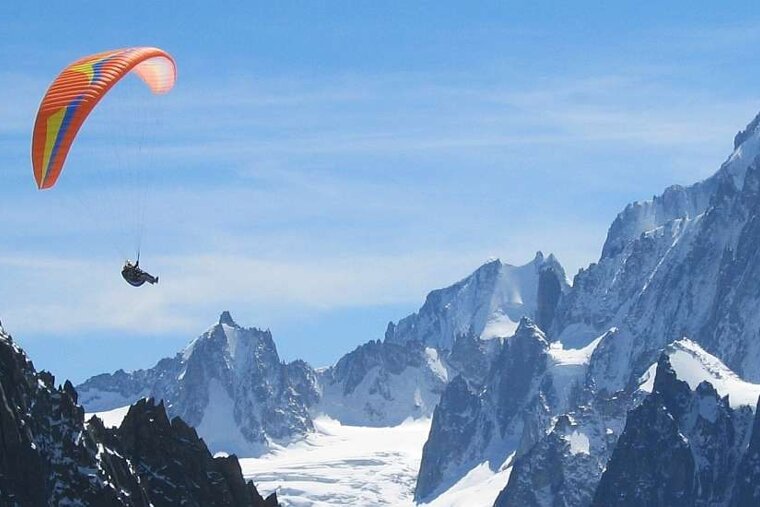
Landing areas
The Chamonix valley has a number of well established official landing areas dotted up and down its length. They are generally well marked with windsocks or flags and you should always visit your chosen landing area prior to taking off as some of them have limited landing sections or tricky aspects to negotiate.
None of the Chamonix landing areas can be seen from the launch sites, however, once in the air they are all very easy to spot. It is imperative that you only land on official sites as not doing so can cause conflict with local landowners. A number of landing areas in the valley have already been lost as a result of the impolite and disrespectful attitudes of a few pilots. If you do encounter problems and are forced to make an emergency landing somewhere, always be polite and apologetic and offer to pay for any damage caused to the landowners’ property or crops if necessary (your third party liability covers you for such eventualities).
A standard tandem flight will last about 20-30 minutes, depending on the thermals and in Chamonix you can fly from Planpraz at Brévent, Flégère, Grands Montets and Les Houches. For a real treat (and conditions permitting) you can also fly off the Aiguille du Midi. In the summer most flights will land on the Savoy nursery slopes at the foot of Brévent, but in winter (as beginners are skiing there!) it tends to be at the Bois du Bouchet near the MBC pub.
| Area | Orientation | Access and ability | Site specifics | Landing field for: |
| Bois du Bouchet | GPS:
N 45° 55' 53" E 006° 52' 43" Altitude: 1,040m |
Access: By car leave the Mont Blanc roundabout (in the centre of town) heading towards Argentière and the landing area is 500m further on, on the left just after the sports centre.
Ability: Beginners to XC pilots. |
This large landing field surrounded by trees is the principle landing area for Chamonix. It is important to go no further downwind than the small road leading to the gravel pit in order to ensure you hit target. In the afternoons, valley winds can reach speeds of up to 20/30km/h. In winter cross country skiing takes priority at Bois du Bouchet so check with one of the clubs or schools for an alternative landing area. | Planpraz,
Plan d’Aiguille, Grands Montets, Aiguille du Midi. |
| Clos du Savoy | GPS:
N 45° 55' 42" E 006° 51' 65" Altitude: 1,050m |
Access: By car leave the Mont Blanc roundabout (in the centre of town) heading towards Le Brévent and at the crossroads by Hotel Alpina turn right – direction Les Praz/Argentière. After 500m, turn left and the landing is on the left, opposite Hotel Sapiniere.
Ability: Autonomous to XC pilots. |
Although this site is large, it is enclosed and surrounded by buildings so you need to be careful, especially later in the day when the valley breeze picks up. This area transforms into the nursery ski slopes in winter and landing here is completely forbidden. Check with one of the clubs or schools for the alternative landing area. | Planpraz |
| Cachat Gravel Pits | GPS:
N 45° 53' 60" E 006° 49' 24" Altitude: 950m |
Access: From Chamonix take the Route des Gaillands in the direction of Les Houches. After Taconnaz turn right into a narrow lane by the roundabout on the main road.
Ability: Autonomous to XC pilot. |
Essential to visit this site before take-off to ensure that the landing area is free of obstacles and that work is not being carried out moving gravel. Approach can be turbulent. | Merlet |
| Le Fayet / Passy - Marlioz (Batistock) | Altitude: 585m | Access: Le Fayet/Passy is at the bottom of the valley and the landing area is on Avenue Grange Vallet (opposite Batistock).
Ability: Supervised beginner XC pilots. |
Landing area is in the north-east corner of the field by the windsock. Be respectful of the crops that grow in the remainder of the field and pack your glider up along the edge of the road. | Prarion - Les Houches & Les Chavants |
| Les Chavants | GPS:
UTM 0327610 E -5085185 Altitude: 1,010m |
Access: Pass by the Prarion cash desk, turn right at the roundabout and follow the metalled road to the end. Do not enter the private gravelled road.
Ability: Autonomous pilots. |
The use of this landing field is highly sensitive and your consideration when using it will help further negotiations to register this site with the FFVL. Please respect the indicated packing and landing areas and do not drive upon, unfold your glider (or even look at) the small track to the south of the landing field. Once the valley wind picks up (around 11:00) landing conditions can be variable and difficult. To be avoided later in the day. | Prarion North Easterly |
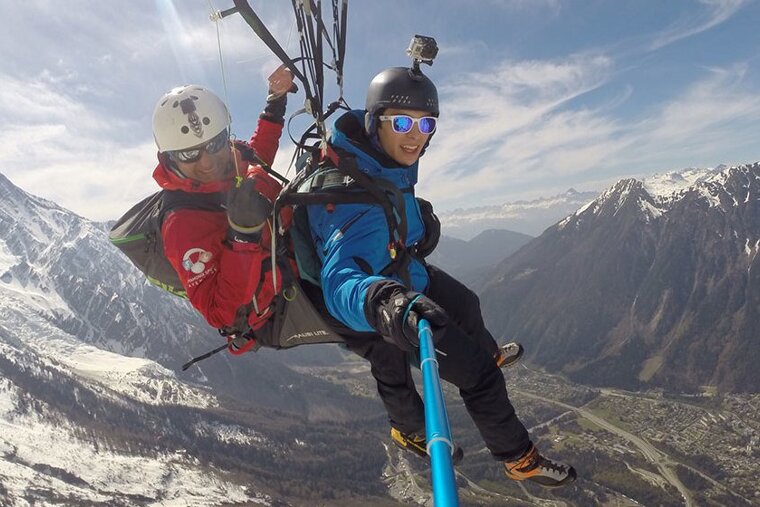
Paragliding equipment
If you’re thinking of travelling here with your own paraglider it's worth doing bit of research into the baggage policies of a couple of airlines for the latest prices and conditions.

Who to paraglide with
There are a number of activity companies and flying schools in Chamonix. Click on the link below to find details.
